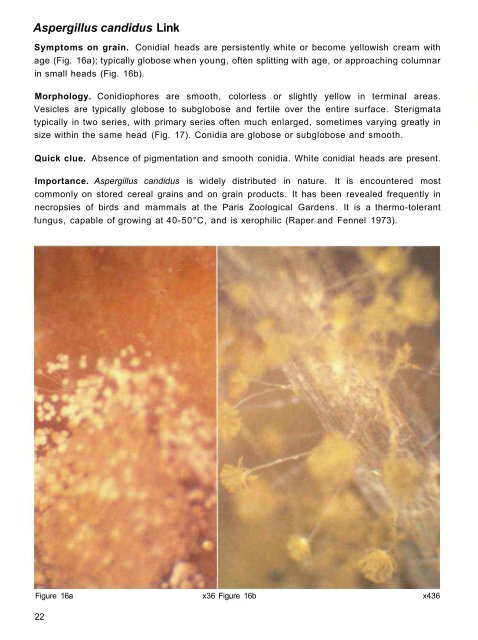A Pictorial Guide for the Identification of Mold ... - OAR@ICRISAT
A Pictorial Guide for the Identification of Mold ... - OAR@ICRISAT
A Pictorial Guide for the Identification of Mold ... - OAR@ICRISAT
Create successful ePaper yourself
Turn your PDF publications into a flip-book with our unique Google optimized e-Paper software.
Aspergillus candidus Link<br />
Symptoms on grain. Conidial heads are persistently white or become yellowish cream with<br />
age (Fig. 16a); typically globose when young, <strong>of</strong>ten splitting with age, or approaching columnar<br />
in small heads (Fig. 16b).<br />
Morphology. Conidiophores are smooth, colorless or slightly yellow in terminal areas.<br />
Vesicles are typically globose to subglobose and fertile over <strong>the</strong> entire surface. Sterigmata<br />
typically in two series, with primary series <strong>of</strong>ten much enlarged, sometimes varying greatly in<br />
size within <strong>the</strong> same head (Fig. 17). Conidia are globose or subglobose and smooth.<br />
Quick clue. Absence <strong>of</strong> pigmentation and smooth conidia. White conidial heads are present.<br />
Importance. Aspergillus candidus is widely distributed in nature. It is encountered most<br />
commonly on stored cereal grains and on grain products. It has been revealed frequently in<br />
necropsies <strong>of</strong> birds and mammals at <strong>the</strong> Paris Zoological Gardens. It is a <strong>the</strong>rmo-tolerant<br />
fungus, capable <strong>of</strong> growing at 40-50°C, and is xerophilic (Raper and Fennel 1973).<br />
Figure 16a x36 Figure 16b x436<br />
22
















